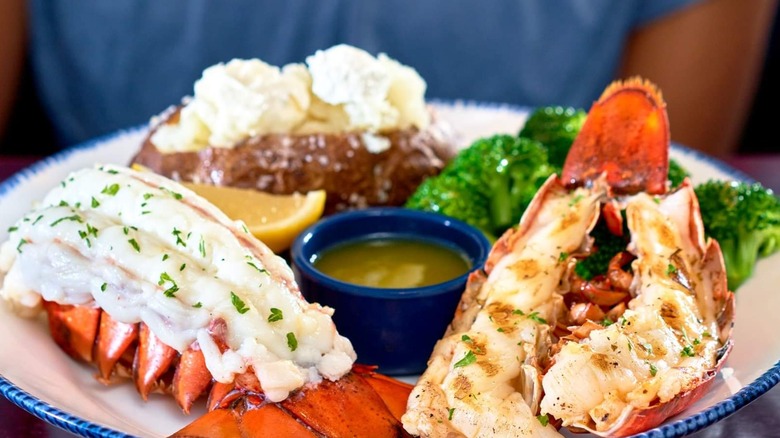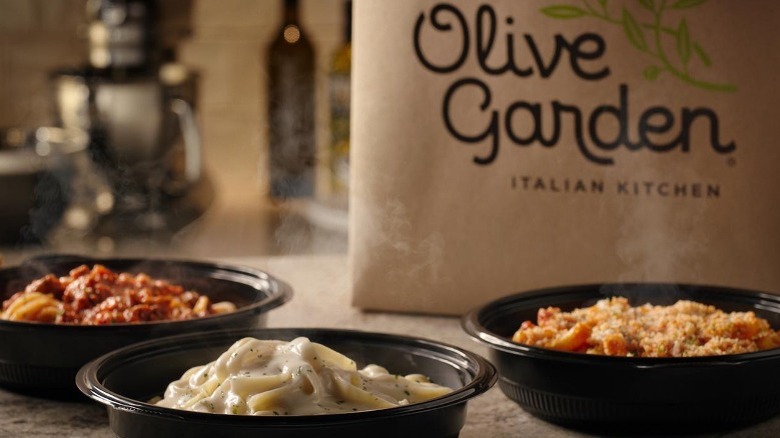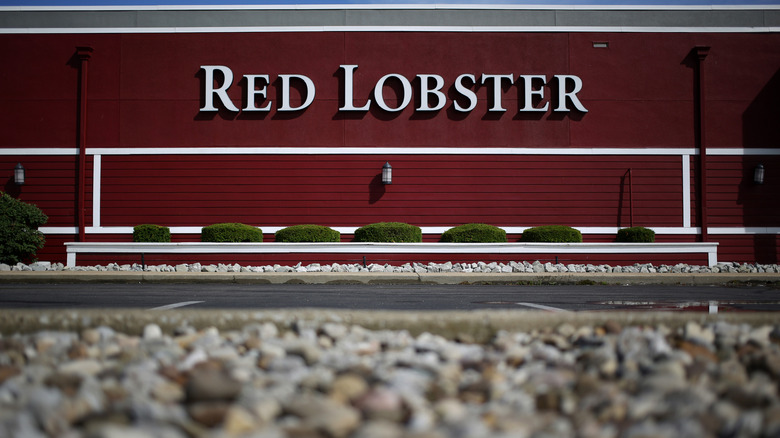The Olive Garden/Red Lobster Hybrid Restaurants You May Have Forgotten
Picture a couple in the 2010s deciding where to dine out for the night. One is craving Olive Garden, while the other is in the mood for Red Lobster. Usually, this would lead to a difficult compromise as they want two different types cuisine. Although this might be grounds for disagreement, there once existed a very simple solution that could satisfy each requirement: why not visit both restaurants at once? No, that doesn't mean they would go to Red Lobster first, then an Olive Garden. Instead, they could have gone to a "hybrid restaurant," or two restaurants that share one space.
According to Eater, these "Red Olives" (or "Lobster Gardens" if you prefer) were roughly the same size as a standard Olive Garden but were split in half, with one side of the restaurant dedicated to Olive Garden operations and the other side to Red Lobster. Although the dining rooms were separate, the kitchen, bar, and bathroom were shared. It's incredible to think that not too long ago, you could order a Tour of Italy during Lobsterfest and it wasn't considered sacrilegious.
Joking aside, why combine two restaurants in the first place? Why pair one establishment specializing in Italian-American cuisine with one that's known for cheddar biscuits and endless shrimp? Like most business-related things, the answer centers around one key concept: maximizing profits from both restaurants as much as possible.
Combining Olive Garden and Red Lobster would help boost revenue
In 2011, Darden Restaurants, which owned Olive Garden and, at the time, Red Lobster, realized that it needed a better way to boost revenue from both restaurants. To achieve this goal, six locations would be built as combination Olive Garden and Red Lobsters, designed to pull more profit using one single restaurant.
Combination restaurants aren't new, even if the combination of Olive Garden and Red Lobster was unconventional. You may have, for example, seen a Taco Bell and a Pizza Hut sharing the same building or perhaps a KFC sharing space with a Long John Silver's. There are many reasons why these combination restaurants exist, to be sure, but one is that the use of a single kitchen and building for two restaurants is a great way to save on resources. It's much cheaper to build one building and use it to house both restaurants than to build two entirely separate structures. Combination restaurants could also appeal to areas that have a low population as, no matter what restaurant the customer chooses, the company would still be making a decent profit.
But it seems that such an achievement wasn't in the cards for Darden Restaurants. Although six combination Olive Gardens/Red Lobsters were opened in total, they shuttered in 2014 and now remain a faint memory of what could have been. But how could the combination of two popular restaurants somehow fail?
Darden Restaurants sold off Red Lobster
On paper, the idea of combining an Olive Garden and Red Lobster in one building doesn't seem so bad. After all, they're popular restaurants, it's cheaper to maintain, and you get the benefits of people visiting two of your restaurants at once. But it would seem that Darden Restaurants had other plans — and a combination Red Lobster and Olive Garden wasn't one of them.
As Eater explains, Darden Restaurants closed all six of its combination restaurants, stating that one of the reasons involved Darden selling off the Red Lobster brand. Since the company would no longer own Red Lobster, the hybrid restaurants would be incredibly hard to operate in their current form. Instead, the plan would be that two of the six combination restaurants would be closed while the rest would quickly be converted into full-fledged Olive Gardens. After all, if these restaurants were already the size of an average Olive Garden restaurant and were basically half-finished Olive Gardens, why not just complete the job?
As of yet, it seems that Darden Restaurants have no plans to introduce another combination restaurant like its Olive Garden and Red Lobster hybrids any time soon. But who knows? Perhaps one day we'll see a combination Olive Garden and LongHorn Steakhouse, selling lasagna and rib-eyes to a hungry crowd.


